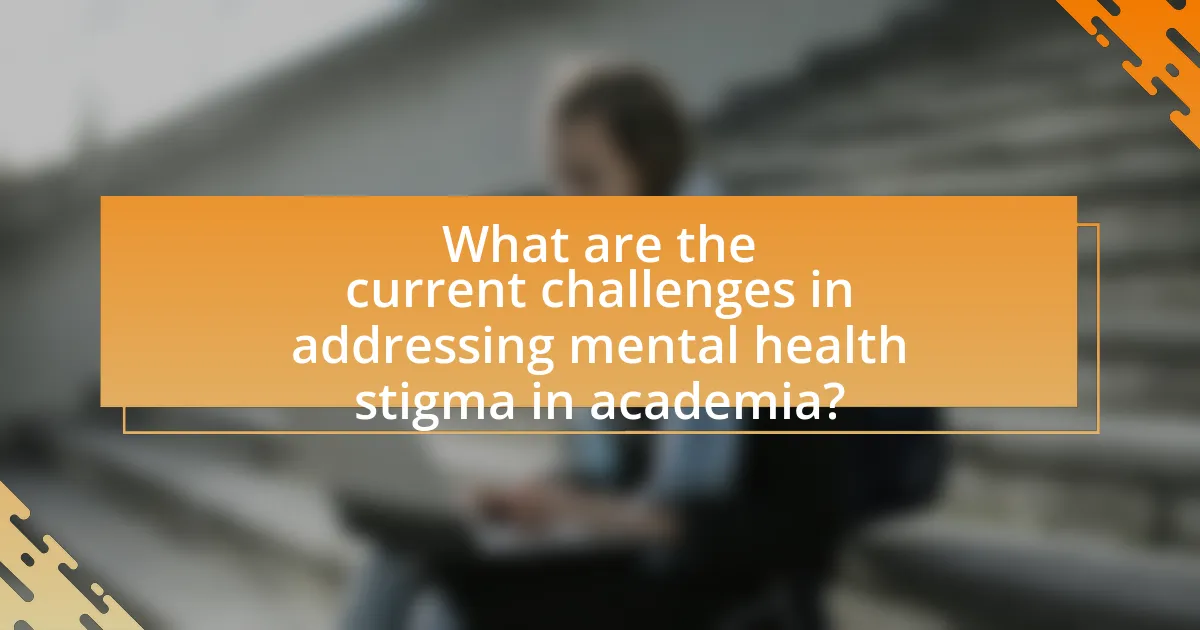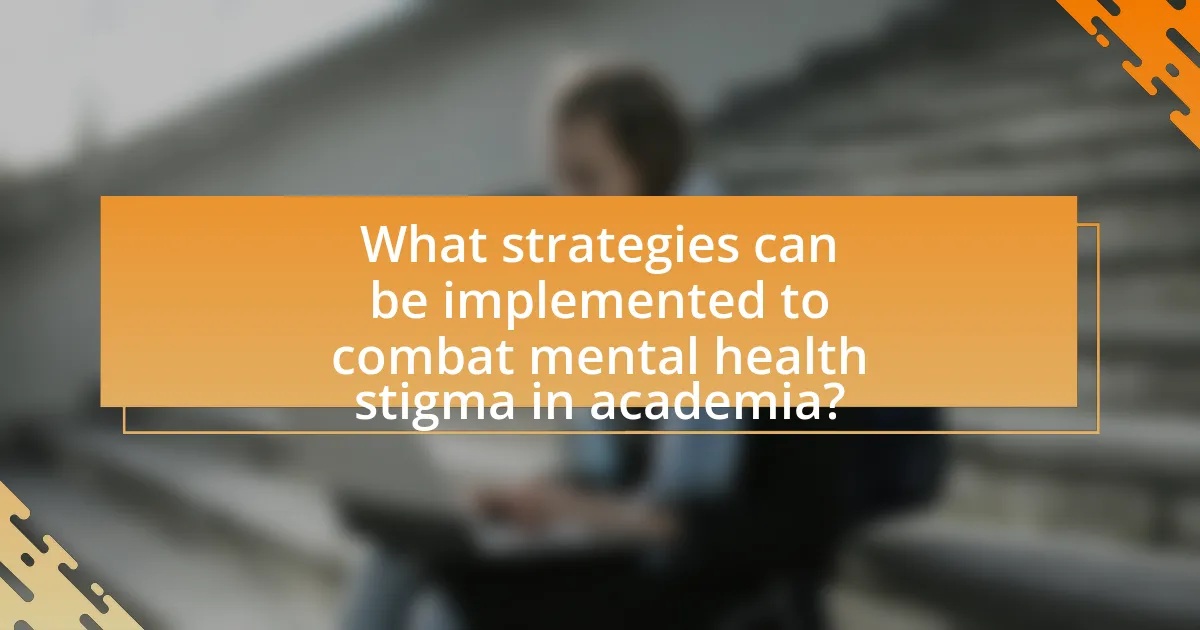Mental health stigma in academia refers to the negative perceptions and discrimination faced by individuals experiencing mental health issues within educational settings. This stigma manifests through stereotypes, social exclusion, and reluctance to seek help, significantly impacting academic performance and overall well-being. Approximately 40% of graduate students report mental health challenges, yet many do not seek assistance due to fear of judgment. The article explores the various ways stigma is perpetuated in academic environments, the consequences of ignoring these issues, and strategies for fostering a supportive culture that encourages open discussions about mental health. It emphasizes the importance of addressing stigma to improve mental health outcomes and academic success for both students and faculty.

What is Mental Health Stigma in Academia?
Mental health stigma in academia refers to the negative attitudes and beliefs surrounding mental health issues that can lead to discrimination and marginalization of individuals experiencing these challenges within academic settings. This stigma often manifests in the form of stereotypes, social exclusion, and reluctance to seek help, which can hinder academic performance and overall well-being. Research indicates that approximately 40% of graduate students report experiencing mental health issues, yet many do not seek help due to fear of judgment or repercussions, highlighting the pervasive nature of stigma in academic environments.
How does mental health stigma manifest in academic environments?
Mental health stigma in academic environments manifests through discrimination, negative stereotypes, and social isolation of individuals experiencing mental health issues. This stigma can lead to students and faculty feeling reluctant to seek help, fearing judgment or academic repercussions. Research indicates that approximately 40% of students with mental health conditions report feeling stigmatized by peers and faculty, which can exacerbate their conditions and hinder academic performance. Additionally, the lack of mental health resources and support systems in many academic institutions further perpetuates this stigma, creating an environment where mental health issues are not openly discussed or addressed.
What are the common stereotypes associated with mental health in academia?
Common stereotypes associated with mental health in academia include the belief that individuals with mental health issues are less competent or capable of performing their academic duties effectively. This stereotype is reinforced by the perception that mental illness is a sign of weakness, leading to stigma and discrimination against those who seek help. Additionally, there is a stereotype that academia is inherently stressful and that individuals who struggle with mental health are simply not cut out for the demands of academic life. Research indicates that these stereotypes contribute to a culture of silence around mental health issues, preventing individuals from seeking necessary support and exacerbating their conditions.
How do these stereotypes impact students and faculty?
Stereotypes surrounding mental health significantly impact both students and faculty by perpetuating stigma, which can lead to decreased willingness to seek help. Students may experience increased anxiety and isolation due to fear of judgment, resulting in lower academic performance and engagement. Faculty members may also feel pressured to conform to these stereotypes, leading to reluctance in discussing mental health issues openly, which can hinder supportive environments. Research indicates that stigma can create barriers to accessing mental health resources, as evidenced by a study published in the Journal of American College Health, which found that 40% of students with mental health concerns did not seek help due to fear of being labeled.
Why is addressing mental health stigma important in academia?
Addressing mental health stigma in academia is crucial because it directly impacts the well-being and academic performance of students and faculty. Stigmatization can lead to decreased help-seeking behavior, resulting in untreated mental health issues that affect productivity and retention rates. Research indicates that approximately 30% of students experience significant mental health challenges, yet only a fraction seek help due to fear of judgment or repercussions. By fostering an environment that openly discusses mental health, institutions can promote a culture of support, enhance academic success, and improve overall campus climate.
What are the consequences of ignoring mental health stigma?
Ignoring mental health stigma leads to significant negative consequences, including increased rates of mental health disorders and reduced help-seeking behavior among individuals. Research indicates that stigma can prevent individuals from accessing necessary mental health services, resulting in untreated conditions that can worsen over time. For instance, a study published in the journal “Psychological Medicine” found that individuals who experience stigma are less likely to seek treatment, which can exacerbate their mental health issues and lead to higher rates of suicide and self-harm. Additionally, ignoring stigma can perpetuate a culture of silence and shame, further isolating those in need of support and hindering overall mental health awareness and education within academic environments.
How can addressing stigma improve academic performance and well-being?
Addressing stigma can significantly improve academic performance and well-being by fostering an inclusive environment that encourages open discussions about mental health. When stigma is reduced, students feel more comfortable seeking help, which leads to better mental health outcomes. Research indicates that students who perceive their environment as supportive are more likely to engage in academic activities and perform better. For instance, a study published in the Journal of American College Health found that students who experienced lower levels of stigma related to mental health were more likely to utilize counseling services, resulting in improved academic performance and overall well-being.

What are the current challenges in addressing mental health stigma in academia?
Current challenges in addressing mental health stigma in academia include a lack of awareness, insufficient support systems, and fear of repercussions. Many academic institutions do not prioritize mental health education, leading to misconceptions and stereotypes about mental illness. Research indicates that 40% of students with mental health issues do not seek help due to stigma (Eisenberg et al., 2009, Journal of American College Health). Additionally, the competitive nature of academia fosters an environment where individuals fear that disclosing mental health struggles may jeopardize their academic standing or career prospects. This fear further perpetuates silence and stigma, making it difficult for institutions to create supportive environments.
What barriers exist for students seeking mental health support?
Barriers for students seeking mental health support include stigma, lack of awareness, and limited access to resources. Stigma surrounding mental health often leads to fear of judgment or discrimination, discouraging students from seeking help. A study published in the Journal of American College Health found that 63% of students reported feeling embarrassed to seek mental health services due to stigma. Additionally, many students lack awareness of available mental health resources, which can prevent them from accessing necessary support. Furthermore, limited availability of mental health professionals on campus and long wait times for appointments create significant obstacles, as highlighted by the American College Health Association, which reported that only 27% of college counseling centers meet the demand for services.
How do institutional policies contribute to mental health stigma?
Institutional policies contribute to mental health stigma by reinforcing negative perceptions and limiting support for individuals with mental health issues. For example, policies that prioritize academic performance over mental well-being can create an environment where students feel pressured to hide their struggles, fearing academic repercussions. Research indicates that institutions with rigid attendance policies may discourage students from seeking help, as they worry about penalties for missing classes due to mental health concerns. Additionally, a lack of mental health resources or inadequate training for staff can perpetuate misunderstandings about mental health, further stigmatizing those who seek assistance. These factors collectively create a culture that marginalizes mental health issues, making it difficult for individuals to openly discuss and address their needs.
What role does peer pressure play in perpetuating stigma?
Peer pressure significantly contributes to the perpetuation of stigma by reinforcing negative attitudes and behaviors towards individuals with mental health issues. In academic environments, students often feel compelled to conform to the prevailing norms and expectations of their peers, which can lead to the marginalization of those who openly discuss or seek help for their mental health struggles. Research indicates that environments characterized by high levels of peer pressure can exacerbate feelings of isolation and shame among affected individuals, thereby entrenching stigma. For instance, a study published in the Journal of American College Health found that students who perceived their peers as stigmatizing mental health issues were less likely to seek help themselves, illustrating the cyclical nature of stigma fueled by peer dynamics.
How do cultural factors influence mental health stigma in academic settings?
Cultural factors significantly influence mental health stigma in academic settings by shaping perceptions and attitudes towards mental health issues. For instance, in collectivist cultures, where community and family reputation are prioritized, individuals may fear that disclosing mental health struggles could lead to shame or ostracism, thereby discouraging help-seeking behaviors. Research indicates that stigma is often reinforced by cultural narratives that associate mental illness with weakness or failure, which can be particularly pronounced in competitive academic environments. A study published in the “Journal of American College Health” found that students from cultures with high stigma levels reported lower rates of seeking mental health services, highlighting the direct impact of cultural beliefs on mental health stigma in academia.
What specific cultural attitudes contribute to stigma in academia?
Cultural attitudes that contribute to stigma in academia include the perception of mental health issues as a sign of weakness and the prioritization of productivity over well-being. These attitudes create an environment where individuals may fear disclosing mental health struggles due to concerns about judgment or career repercussions. Research indicates that 40% of academics report feeling pressure to maintain a façade of competence, which exacerbates feelings of isolation and discourages seeking help. Additionally, the competitive nature of academia fosters a culture that often values achievement and resilience, further marginalizing those who experience mental health challenges.
How can cultural awareness help in reducing stigma?
Cultural awareness can significantly reduce stigma by fostering understanding and empathy towards diverse experiences and perspectives. When individuals are educated about different cultural backgrounds, they become more sensitive to the challenges faced by others, particularly in mental health contexts. Research indicates that stigma often arises from misconceptions and lack of knowledge; for instance, a study published in the “Journal of Mental Health” found that increased cultural competence among healthcare providers led to improved patient outcomes and reduced stigma (Sue et al., 2016). By promoting cultural awareness, institutions can create an inclusive environment that encourages open discussions about mental health, ultimately diminishing stigma and supporting those affected.

What strategies can be implemented to combat mental health stigma in academia?
To combat mental health stigma in academia, institutions can implement comprehensive awareness programs that educate faculty, staff, and students about mental health issues. Research indicates that educational interventions can significantly reduce stigma; for instance, a study published in the Journal of American College Health found that mental health literacy programs led to a 30% decrease in stigma-related attitudes among participants. Additionally, creating supportive environments through peer support groups and mental health resources fosters open discussions, which further diminishes stigma. Establishing policies that promote mental health days and accommodations for mental health conditions also contributes to a culture of acceptance and understanding.
How can educational institutions promote mental health awareness?
Educational institutions can promote mental health awareness by implementing comprehensive mental health education programs. These programs can include workshops, seminars, and courses that educate students and staff about mental health issues, coping strategies, and available resources. Research indicates that institutions that actively engage in mental health education see a reduction in stigma and an increase in help-seeking behavior among students (Eisenberg et al., 2009, Journal of American College Health). Additionally, creating supportive environments through peer support groups and accessible counseling services further enhances awareness and encourages open discussions about mental health.
What types of training can faculty and staff receive to address stigma?
Faculty and staff can receive training in mental health awareness, bias reduction, and effective communication strategies to address stigma. Mental health awareness training educates participants about mental health conditions, their prevalence, and the impact of stigma on individuals. Bias reduction training focuses on recognizing and mitigating personal biases that contribute to stigma, while effective communication strategies teach faculty and staff how to engage in supportive conversations with students and colleagues. Research indicates that such training programs can significantly improve attitudes toward mental health and reduce stigma in academic environments. For instance, a study published in the Journal of American College Health found that mental health training for faculty led to increased knowledge and decreased stigma among participants.
How can student-led initiatives contribute to reducing stigma?
Student-led initiatives can significantly contribute to reducing stigma by fostering open dialogue and creating supportive environments for mental health discussions. These initiatives often involve peer-led workshops, awareness campaigns, and support groups that encourage students to share their experiences and challenges related to mental health. Research indicates that peer support can enhance understanding and empathy, which are crucial in combating stigma. For instance, a study published in the Journal of American College Health found that student-led mental health programs increased awareness and reduced negative perceptions about mental health issues among peers. By actively engaging students in these initiatives, institutions can create a culture of acceptance and understanding, ultimately leading to a decrease in stigma surrounding mental health.
What role does policy change play in addressing mental health stigma?
Policy change plays a crucial role in addressing mental health stigma by creating an environment that promotes understanding and support for individuals with mental health issues. Effective policies can lead to increased funding for mental health services, implementation of educational programs that raise awareness, and the establishment of anti-discrimination laws that protect individuals with mental health conditions. For instance, the Mental Health Parity and Addiction Equity Act of 2008 in the United States mandated that mental health services be covered by insurance plans on par with physical health services, which has contributed to reducing stigma by normalizing mental health care as an essential component of overall health.
What specific policies can be enacted to support mental health in academia?
To support mental health in academia, institutions can implement policies such as mandatory mental health training for faculty and staff, increased access to counseling services, and the establishment of mental health days for students and employees. Mandatory training equips educators with the skills to recognize and address mental health issues, fostering a supportive environment. Increased access to counseling services, such as on-campus mental health professionals, ensures that students and staff receive timely support; studies show that universities with robust mental health services report lower rates of student anxiety and depression. Additionally, allowing mental health days acknowledges the importance of mental well-being, similar to sick leave policies, which can reduce stigma and encourage individuals to prioritize their mental health without fear of academic repercussions.
How can institutions measure the effectiveness of these policies?
Institutions can measure the effectiveness of policies addressing mental health stigma by utilizing surveys and assessments to gauge changes in attitudes and behaviors among students and staff. For instance, pre- and post-implementation surveys can quantify shifts in perceptions of mental health, revealing the impact of educational initiatives and support services. Additionally, tracking utilization rates of mental health resources, such as counseling services, can provide concrete data on whether policies are encouraging individuals to seek help. Research indicates that institutions that implement comprehensive mental health programs see a 20% increase in help-seeking behavior among students, demonstrating the effectiveness of targeted interventions.
What practical steps can individuals take to support mental health in academia?
Individuals can support mental health in academia by fostering open communication about mental health issues. Encouraging discussions among peers and faculty can reduce stigma and create a supportive environment. Research indicates that institutions with mental health awareness programs see a decrease in reported mental health issues among students and staff. Additionally, individuals can participate in or organize workshops that focus on stress management and resilience-building techniques, which have been shown to improve overall well-being in academic settings. Providing resources such as access to counseling services and promoting self-care practices are also effective steps.
How can students advocate for mental health resources on campus?
Students can advocate for mental health resources on campus by organizing awareness campaigns and engaging in dialogue with administration. By forming student-led organizations focused on mental health, they can create platforms for discussion and raise awareness about the importance of mental health services. Research indicates that peer-led initiatives can significantly reduce stigma and increase utilization of mental health resources, as seen in studies conducted by the American Psychological Association, which highlight the effectiveness of student advocacy in promoting mental health awareness. Additionally, students can gather data on mental health needs through surveys, presenting this information to decision-makers to support their case for increased resources.
What are some best practices for fostering a supportive academic environment?
Best practices for fostering a supportive academic environment include promoting open communication, providing mental health resources, and encouraging inclusivity. Open communication allows students and faculty to express concerns without fear of stigma, which is essential for addressing mental health issues. Providing mental health resources, such as counseling services and workshops, ensures that individuals have access to support when needed. Encouraging inclusivity fosters a sense of belonging, which has been shown to improve overall well-being and academic performance. Research indicates that supportive environments can significantly reduce anxiety and depression among students, thereby enhancing their academic experience.



